I’ve always been fascinated by the world of birds, and one bird that particularly stands out to me is the Indian Pitta. This colorful avian creature boasts a multi-hued plumage that’s nothing short of breathtaking.
It’s known for its rich, melodic calls and shy nature, which makes spotting this elusive beauty in the wild a memorable experience.
The Indian Pitta, often referred to as the ‘jewel of the forest’, is native to South Asia where it thrives during warm summer months before migrating southward for winter.
This seasonal traveler isn’t just captivating due to its vibrant appearance; its unique behavioral traits make it stand out among other avifauna.
While I’ll delve into more specifics about this bird species later on, let’s first focus on its distinguishing physical characteristics.
The Indian Pitta sports nine different colors – making it an incredibly showy bird with a brilliant combination of blue, green, yellow, red, and white hues adorning its body.
But don’t be fooled by these bright colors! They serve as excellent camouflage in their preferred leafy habitats.
Physical Characteristics of the Indian Pitta
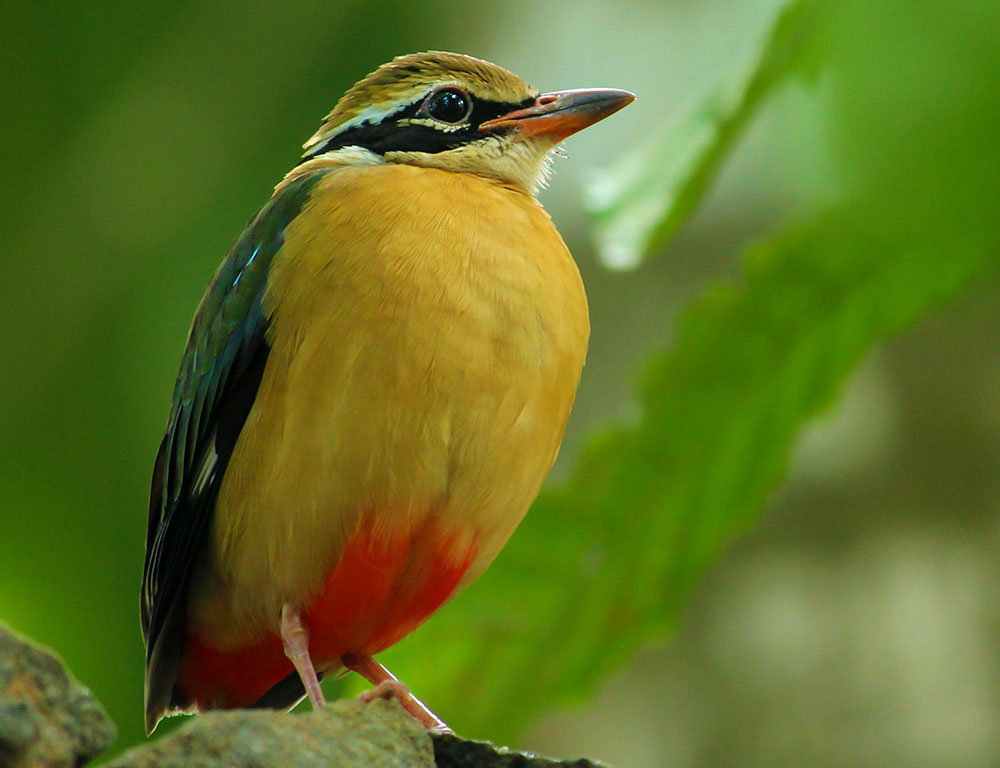
The Indian Pitta (Pitta brachyura) is a striking bird renowned for its vibrant plumage and distinctive features.
Here’s a summary of its physical characteristics:
Size
The Indian Pitta typically measures 7 to 9 inches, making it slightly larger than an average sparrow.
Coloration
During its breeding season, which typically occurs from April to July, the Indian Pitta displays a dazzling array of colors. These include:
- Blue crown and tail
- Emerald green wings
- Bright yellow underparts
- Shades of flaming orange and red on the chest and flanks
Key Features
- Beak: The Indian Pitta has a strong beak, which it uses for various tasks such as foraging for food.
- Tail: It sports a short tail, adding to its distinctive appearance.
Adaptations
The Indian Pitta’s vibrant plumage serves a purpose beyond aesthetics. It aids in attracting mates during the breeding season.
Outside of this period, the bird adopts more muted tones that blend well with its forest habitats, enhancing its camouflage and making it harder for predators to spot.
Weight and Age Variations
There’s little recorded difference in weight between males and females or adults and juveniles. However, older birds are noted to possess brighter colors compared to younger ones, likely playing a role in mate attraction.
Habitat and Distribution of the Indian Pitta
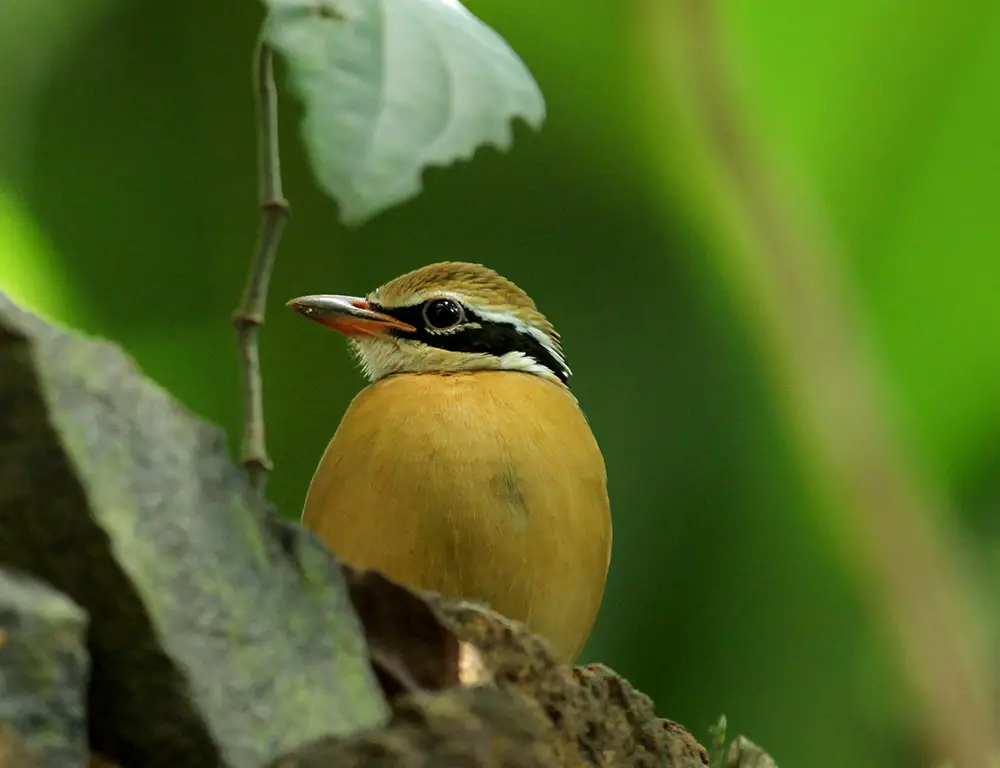
The Indian Pitta’s habitat and distribution are characterized by its preference for deciduous forests and dense undergrowth, as well as its wide range across the Indian subcontinent and beyond.
Here are some key points regarding its habitat and distribution:
Habitat Preference
Indian Pittas primarily inhabit deciduous forests and areas with thick vegetation where they can easily hide from predators and forage for food on the ground. They also nest close to water bodies like rivers or ponds, which provide abundant insect prey.
Distribution Range
During the breeding season between April and August, Indian Pittas can be found across most parts of South Asia, including countries like India, Nepal, Bhutan, and Bangladesh.
Migration
In winter, Indian Pittas migrate southwards to warmer regions, including Sri Lanka and Southeast Asian countries such as Thailand and Indonesia.
Conservation Status
Although Indian Pittas are not officially classified as endangered according to the IUCN status, their population is declining due to habitat loss caused by deforestation and urbanization.
Conservation efforts to preserve their natural habitats are crucial to ensuring the continued survival of this species.
Here’s a quick look at their population size across different regions:
| Region | Estimated Population Size |
|---|---|
| India | 10000-20000 pairs |
| Nepal | 2500-5000 pairs |
| Bhutan | Not Available |
| Bangladesh | Not Available |
Diet and Feeding Habits of the Indian Pitta
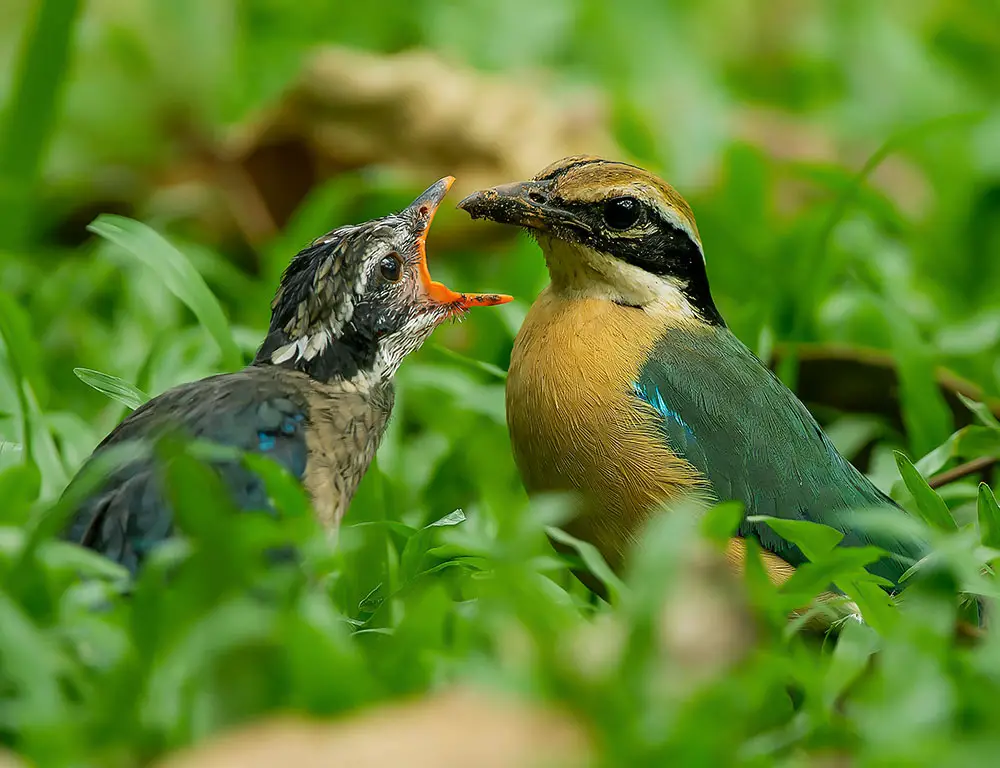
The Indian Pitta’s diet and feeding habits reflect its adaptability and omnivorous nature. Here are the key points regarding its diet and feeding behavior:
Broad Diet
Indian Pittas consume a wide variety of foods, including insects such as beetles, ants, caterpillars, small reptiles like geckos or skinks, berries, and seeds. This broad diet makes them omnivores, allowing them to exploit various food sources available in their habitat.
Ground-foraging
They are known for their ground-foraging habits, hopping around on the forest floor and using their strong beaks to peck at the ground in search of food. This behavior allows them to hunt for insects and other prey items efficiently.
Agility in Hunting
Indian Pittas exhibit impressive agility when catching prey such as beetles or ants. Despite their small size, they are skilled hunters capable of capturing fast-moving insects.
Diurnal Feeding
Indian Pittas are primarily diurnal feeders, hunting for food during daylight hours. This aligns with their ground-foraging behavior, as they rely on visual cues to locate prey.
Adaptability
Being omnivores gives Indian Pittas an advantage over species with more restricted dietary preferences. Their ability to consume various foods allows them to thrive across different habitats and environments.
Challenges in Research
While the general dietary preferences of Indian Pittas are known, detailed quantitative data regarding their feeding habits may be limited due to a lack of extensive research in this field.
However, observations and anecdotal evidence suggest their diverse diet and adaptable feeding behavior.
Breeding and Nesting Behavior of the Indian Pitta
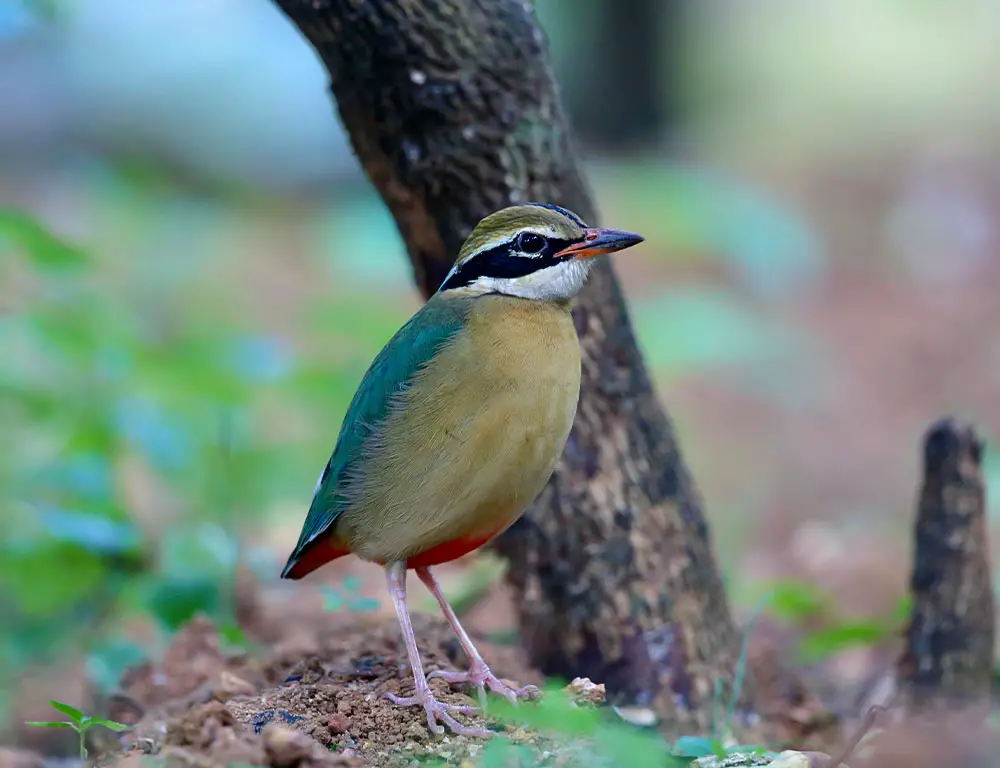
Several fascinating aspects characterize the breeding and nesting behavior of the Indian Pitta:
Breeding Season
Indian Pittas mainly breed during the monsoon season, typically from June to August in India. This is when their distinctive plumage is at its most vibrant, attracting the attention of bird watchers.
Nesting Habitat
These birds prefer quiet and secluded spaces for nesting, often selecting thick bushes or dense foliage. The nest is a meticulously crafted circular structure made of twigs, grasses, and leaves, with a cozy interior lined with soft materials like feathers and moss.
Nest Construction
Both male and female Indian Pittas participate in nest-building. The male usually initiates construction by collecting materials, with the female joining soon after. Their harmonious teamwork allows them to complete the nest within 5-7 days.
Clutch Size
Indian Pittas typically lay 4-6 eggs per clutch. These tiny eggs have a beautiful pinkish-white hue speckled with reddish-brown spots.
Incubation Period
Incubation duties are shared between parents over 14-16 days before the chicks hatch.
Parental Care
After hatching, Indian Pitta parents exhibit engaging parental behavior, including feeding regimens and vigilant protection against predators. Fledging occurs roughly around two weeks after hatching.
Conservation Status of the Indian Pitta
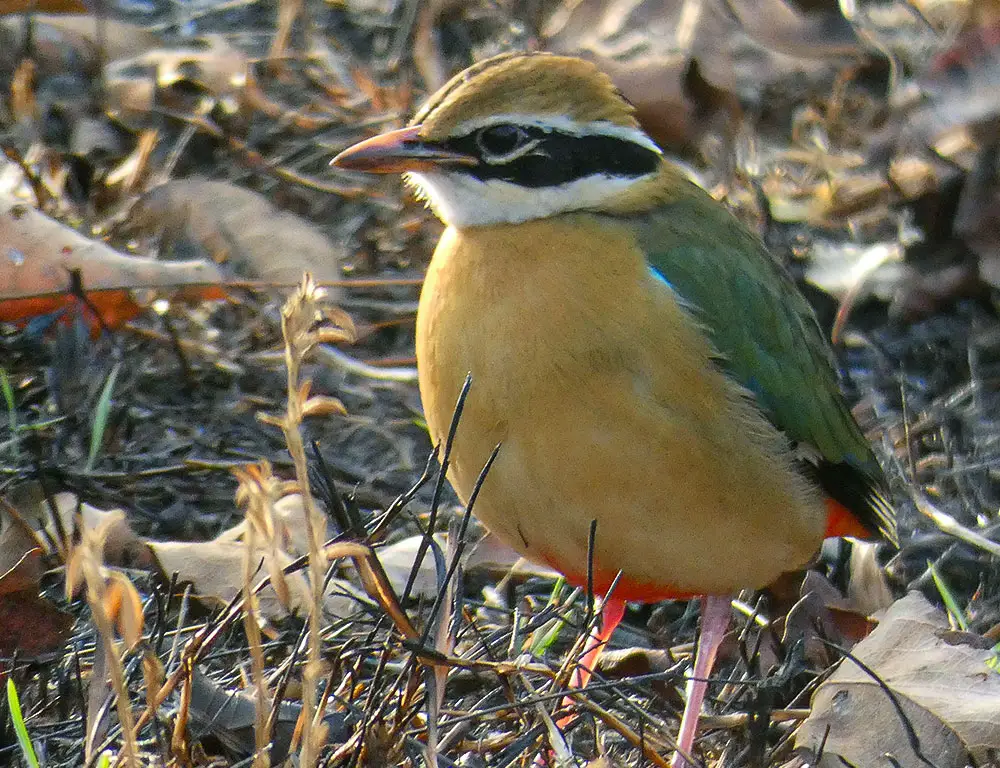
The conservation status of the Indian Pitta, classified as “Least Concern” by the International Union for Conservation of Nature (IUCN), belies the significant threats it faces to its survival.
Here’s an overview of the challenges and conservation efforts:
Habitat Destruction
Urbanization and deforestation have led to the loss and fragmentation of the Indian Pitta’s natural habitats. While there has been a marginal increase in forest cover over the years, the ongoing destruction of dense forests poses a severe threat to the species.
Illegal Hunting and Capture
Despite legal protections under the Wildlife Protection Act of India, Indian Pittas are still subjected to local hunting and capture for the pet trade. Weak enforcement of laws contributes to the persistence of these illegal activities.
Conservation Actions
Various conservation efforts have been initiated to mitigate these threats, including establishing and managing national parks and sanctuaries to protect habitats.
Strengthening legal action against illegal hunting and trapping and conducting awareness campaigns to educate the public about the importance of wildlife conservation are also crucial steps being taken.
Conclusion
After delving into the fascinating world of the Indian Pitta, I’ve come to appreciate this bird’s unique characteristics and significance in its native habitats. This colorful creature is more than just a pretty face; it plays an integral role in maintaining the ecological balance.
What truly amazes me about the Indian Pitta is its vibrant plumage. You’ll not often find such a riot of colors on a single bird. The mix of blue, green, yellow, red, and white makes for a striking sight that’s hard to forget.
Let’s take a brief look at some key facts about this remarkable bird:
- Scientific name: Pitta brachyura
- Habitat: Dense forests across India
- Diet: Insects, small reptiles, and berries
- Breeding season: May to July
- Status: Least Concern (LC) but with decreasing population trend
The Indian Pitta has quite an expansive range extending from the foothills of the Himalayas down to Southern India. However, despite being widespread, it remains elusive due to its preference for dense undergrowth and secretive behavior.
In essence, studying the Indian Pitta isn’t merely indulging our fascination with exotic wildlife. It’s also contributing towards preserving biodiversity – something I believe should concern us all deeply.